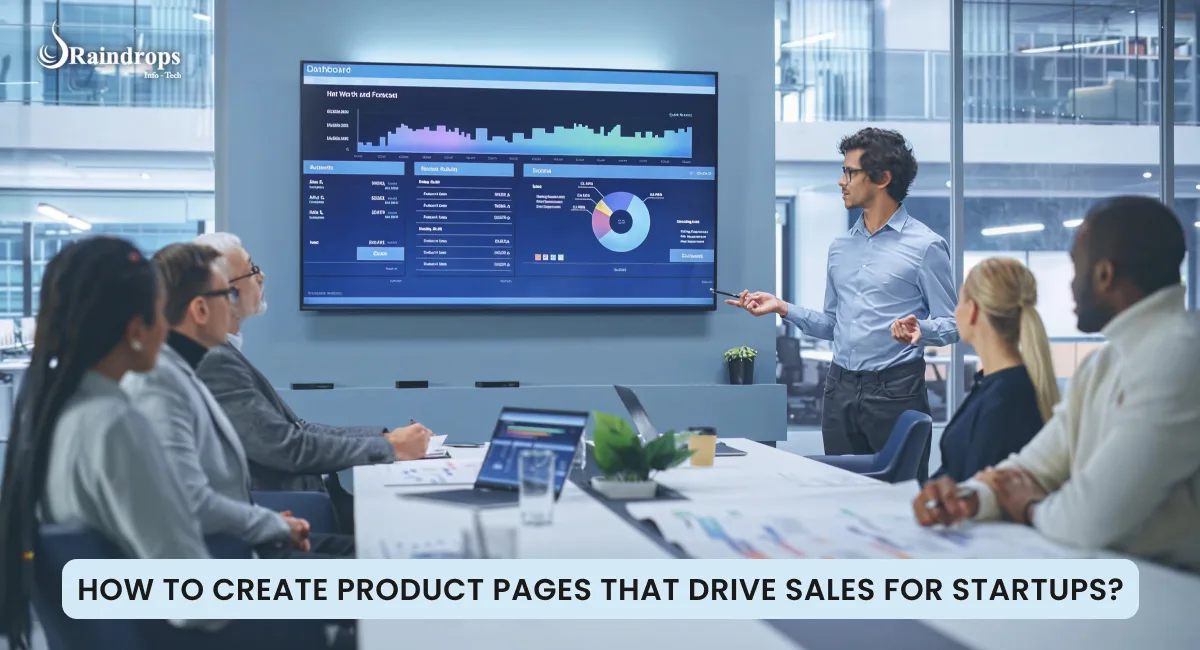You’ve put in the work- built an amazing product, launched your startup, and even managed to drive traffic to your website. But there’s just one problem… no one’s buying. Frustrating, right? You’re not alone.
The truth is, most product pages aren’t built to convert. They look decent, sure, but they don’t do the one thing they’re supposed to—convince people to buy.
The good news? You don’t need a complete website change. With a few smart changes, you can turn your product pages into sales machines: just clear, practical steps to help you sell more (without spending much on ads). Let’s understand it in detail!

The Perfect Product Page Formula (Step-by-Step Guide)
1. Craft a Benefit-Driven Product Title
Your title is the first thing a customer sees. If it’s vague or unexciting, they won’t feel the need to learn more.
What Makes a Strong Product Title?
Clarity: Avoid generic names—describe the product’s core benefit.
SEO Optimization: Use relevant keywords to improve discoverability.
Emotional Appeal: Highlight what makes your product better than the rest.
Bad Example: Wireless Earbuds Model X1
Good Example: Wireless Noise-Canceling Earbuds – 30-Hour Battery & Fast Charging
This simple change makes a huge difference and can make your product stand out.

2. Write a Product Description That Sells
Most brands make the mistake of listing product features without explaining why they matter. Always remember the gold rule: Customers don’t buy features they buy solutions. The main aim of your product should be solving the problem of the customer– so do it!
How to Write a High-Converting Product Description?
Start with a hook – People have short attention spans. Engage your reader immediately.
Focus on benefits, not just features – Explain how it improves their life. How it solves their problems. How it will help them.
Use bullet points for readability – Keep it scannable and clear. They wont read your heavy paragraphs.
Keep it simple – Avoid jargon and overly technical details. Your main aim is to communicate to your audience, so make things simple and easy.
Example:
Industry-leading noise cancellation blocks out distractions.
30-hour battery life keeps you powered all day.
Fast charging – 10 minutes of charge gives 3 hours of playtime.

3. Use High-Quality Images & Videos
Obviously, customers can’t physically touch your product online, so your visuals must do all the convincing. And it is a universal truth that images create more impact than just text.
How to Optimize Product Images?
Use high-resolution photos – No pixelation or blurry images.
Show multiple angles – Give a complete view of the product.
Lifestyle images – Show people using the product in real-life scenarios.
Include a demo video – A short, engaging video can boost conversions by 80%.
If a picture is worth a thousand words, a high-quality product image is worth thousands in sales.

4. Build Trust with Social Proof
Always remember that people trust other people, not brands. If your page lacks reviews or testimonials, visitors will hesitate to buy.
How to Add Social Proof?
Display customer reviews – 95% of shoppers read reviews before purchasing.
Showcase star ratings – A 4.5+ star rating instantly boosts credibility.
Use real customer photos – User-generated content builds authenticity. News flash: People don’t trust mere bots.
Highlight guarantees – “100% Money-Back Guarantee” removes risk.
Trust is non-negotiable. Without it, even the best product won’t sell.

5. Use Persuasive Calls-to-Action (CTAs)
Your “Buy Now” button isn’t just a button—it’s your final shot at closing the sale. If it’s weak, boring, or vague, people will hesitate. And hesitation means lost revenue.
How to Create High-Converting CTAs?
Instead of the plain old “Add to Cart,” try something that sparks urgency and excitement:
“Get Yours Today – Limited Stock!” (Makes people act fast)
“Order Now & Get Free Shipping!” (Adds an extra incentive)
“Claim Your Discount Before Midnight!” (Creates urgency)
Even small tweaks to your CTA wording can lead to a big jump in conversions. The goal? Make clicking that button feel like an opportunity, not just an action.

6. Create Urgency & FOMO (Fear of Missing Out)
Most people don’t buy immediately. They think, “I’ll get it later.” But later often turns into never. That’s why urgency works—it forces instant action.
How to Create Urgency That Drives Sales?
Low Stock Alerts – “Only 3 left in stock!” (Triggers FOMO)
Limited-Time Offers – “Flash Sale: Ends in 2 hours!” (Adds pressure)
Fast Shipping Incentives – “Order Now for Same-Day Delivery!” (Encourages impulse purchases)
Urgency removes hesitation and pushes people to buy now. Without it, they’ll just scroll away—and you’ll lose the sale.

7. Optimize for Mobile & Speed
Over 70% of online shoppers use their phones. If your product page isn’t fast and mobile-friendly, you’re handing sales to your competitors.
How to Improve Mobile Experience?
Keep load time under 3 seconds – Speed is everything.
Use a mobile-friendly design – Large buttons, simple navigation, no clutter.
Optimize images – Compress them so they load fast without looking blurry.
Test with Google PageSpeed Insights – Find and fix slow-loading elements.
A one-second delay in page load time can cost you thousands in lost revenue. Every second counts—make sure your site loads fast and looks great on mobile.

8. SEO Optimization
Last but not the least, our main ingredient- SEO! Even the best product page is useless if no one finds it. That’s why SEO is non-negotiable—it brings in free, organic traffic from search engines.
How to Optimize for Search Engines
Use Long-Tail Keywords – Example: “Best noise-canceling earbuds under ₹5000” (More specific = higher chances of ranking)
Add Keywords in Key Areas – Title, description, image alt text, and URL.
Internal Linking – Link to related products and relevant blog posts to keep visitors engaged.
Use Schema Markup – Helps Google display rich snippets (ratings, price, availability) in search results.
SEO isn’t just about ranking, it’s about getting found by the right people at the right time. And that means more organic sales with zero ad spend.

Final Thoughts: Your Action Plan
Your product page isn’t just a digital shelf, it’s your silent salesperson working 24/7 to turn visitors into buyers. Every detail matters, from the headline to the “Buy Now” button.
What to Do Right Now:
Revamp Your Titles & Descriptions – Focus on benefits, not just features.
Upgrade Your Visuals – Use high-quality images and a compelling demo video.
Add Social Proof – Customer reviews, ratings, and trust badges build credibility.
Optimize for SEO & Speed – Ensure your page ranks and loads in under 3 seconds.
A high-converting product page isn’t just about looking good—it’s about persuading visitors to buy. Apply these strategies and watch your sales grow.
Need help optimizing your product pages for more conversions? Let Raindrops Infotech do the heavy lifting. From stunning UI/UX design to SEO-friendly development, we build eCommerce experiences that sell.
Schedule a free consultation today and turn more clicks into customers!
FAQS
What makes a product page high-converting?
A high-converting product page has a clear benefit-driven title, persuasive descriptions, high-quality images, social proof, and a strong call-to-action (CTA) to drive sales.
How can I write a product description that boosts sales?
Focus on benefits rather than just features. Use engaging, easy-to-scan bullet points, avoid jargon, and create a compelling hook that highlights how the product solves a problem.
Why is social proof important on a product page?
Customer reviews, ratings, and user-generated content build trust and credibility, making potential buyers more likely to purchase your product.
How do I optimize my product page for SEO?
Use long-tail keywords in the title, description, and image alt text, optimize page speed, include internal links, and apply schema markup for better search engine visibility.
What are the best call-to-action (CTA) strategies for product pages?
Use urgency-driven CTAs like “Limited Stock – Buy Now” or incentive-based ones like “Order Today & Get Free Shipping” to encourage immediate action.
